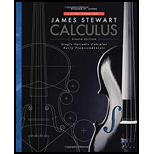
Study Guide for Stewart's Single Variable Calculus: Early Transcendentals, 8th
8th Edition
ISBN: 9781305279148
Author: Stewart, James, St. Andre, Richard
Publisher: Cengage Learning
expand_more
expand_more
format_list_bulleted
Question
Chapter 11.10, Problem 6PT
To determine
Whether the given statement is true or false.
Expert Solution & Answer
Trending nowThis is a popular solution!

Students have asked these similar questions
Decide whether each limit exists. If a limit exists, estimate its
value.
11. (a) lim f(x)
x-3
f(x) ↑
4
3-
2+
(b) lim f(x)
x―0
-2
0
X
1234
Determine whether the lines
L₁ (t) = (-2,3, −1)t + (0,2,-3) and
L2 p(s) = (2, −3, 1)s + (-10, 17, -8)
intersect. If they do, find the point of intersection.
Convert the line given by the parametric equations y(t)
Enter the symmetric equations in alphabetic order.
(x(t)
= -4+6t
= 3-t
(z(t)
=
5-7t
to symmetric equations.
Chapter 11 Solutions
Study Guide for Stewart's Single Variable Calculus: Early Transcendentals, 8th
Ch. 11.1 - Prob. 1PTCh. 11.1 - Prob. 2PTCh. 11.1 - Prob. 3PTCh. 11.1 - Prob. 4PTCh. 11.1 - Prob. 5PTCh. 11.1 - Prob. 6PTCh. 11.1 - Prob. 7PTCh. 11.1 - Prob. 8PTCh. 11.2 - Prob. 1PTCh. 11.2 - Prob. 2PT
Ch. 11.2 - Prob. 3PTCh. 11.2 - Prob. 4PTCh. 11.2 - Prob. 5PTCh. 11.2 - Prob. 6PTCh. 11.2 - Prob. 7PTCh. 11.2 - Prob. 8PTCh. 11.3 - For what values of p does the series ...Ch. 11.3 - Prob. 2PTCh. 11.3 - Prob. 3PTCh. 11.3 - Prob. 4PTCh. 11.3 - Prob. 5PTCh. 11.3 - Prob. 6PTCh. 11.4 - Prob. 1PTCh. 11.4 - Prob. 2PTCh. 11.4 - Prob. 3PTCh. 11.4 - Prob. 4PTCh. 11.4 - Prob. 5PTCh. 11.5 - Prob. 1PTCh. 11.5 - Prob. 2PTCh. 11.5 - Prob. 3PTCh. 11.5 - Prob. 4PTCh. 11.6 - Prob. 1PTCh. 11.6 - True or False:
If , then converge absolutely.
Ch. 11.6 - True or False:
Every series must do one of these:...Ch. 11.6 - Which is true about the series...Ch. 11.6 - Prob. 5PTCh. 11.6 - Prob. 6PTCh. 11.7 - Prob. 1PTCh. 11.7 - Prob. 2PTCh. 11.7 - Prob. 3PTCh. 11.7 - Prob. 4PTCh. 11.7 - Prob. 5PTCh. 11.7 - Prob. 6PTCh. 11.8 - Prob. 1PTCh. 11.8 - Prob. 2PTCh. 11.8 - Prob. 3PTCh. 11.8 - Prob. 4PTCh. 11.8 - Prob. 5PTCh. 11.9 - Prob. 1PTCh. 11.9 - Prob. 2PTCh. 11.9 - Prob. 3PTCh. 11.9 - Prob. 4PTCh. 11.9 - Prob. 5PTCh. 11.10 - Prob. 1PTCh. 11.10 - Prob. 2PTCh. 11.10 - Prob. 3PTCh. 11.10 - Prob. 4PTCh. 11.10 - Prob. 5PTCh. 11.10 - Prob. 6PTCh. 11.10 - Prob. 7PTCh. 11.10 - Prob. 8PTCh. 11.10 - Prob. 9PTCh. 11.10 - is the binomial series for:
Ch. 11.10 - Using a binomial series, the Maclaurin series for ...Ch. 11.10 - Prob. 12PTCh. 11.11 - Prob. 1PTCh. 11.11 - Prob. 2PTCh. 11.11 - Prob. 3PT
Knowledge Booster
Learn more about
Need a deep-dive on the concept behind this application? Look no further. Learn more about this topic, calculus and related others by exploring similar questions and additional content below.Similar questions
- Find the point at which the line (t) = (4, -5,-4)+t(-2, -1,5) intersects the xy plane.arrow_forwardFind the distance from the point (-9, -3, 0) to the line ä(t) = (−4, 1, −1)t + (0, 1, −3) .arrow_forward1 Find a vector parallel to the line defined by the parametric equations (x(t) = -2t y(t) == 1- 9t z(t) = -1-t Additionally, find a point on the line.arrow_forward
- Find the (perpendicular) distance from the line given by the parametric equations (x(t) = 5+9t y(t) = 7t = 2-9t z(t) to the point (-1, 1, −3).arrow_forwardLet ä(t) = (3,-2,-5)t + (7,−1, 2) and (u) = (5,0, 3)u + (−3,−9,3). Find the acute angle (in degrees) between the lines:arrow_forwardA tank initially contains 50 gal of pure water. Brine containing 3 lb of salt per gallon enters the tank at 2 gal/min, and the (perfectly mixed) solution leaves the tank at 3 gal/min. Thus, the tank is empty after exactly 50 min. (a) Find the amount of salt in the tank after t minutes. (b) What is the maximum amount of salt ever in the tank?arrow_forward
arrow_back_ios
SEE MORE QUESTIONS
arrow_forward_ios
Recommended textbooks for you
 Calculus: Early TranscendentalsCalculusISBN:9781285741550Author:James StewartPublisher:Cengage Learning
Calculus: Early TranscendentalsCalculusISBN:9781285741550Author:James StewartPublisher:Cengage Learning Thomas' Calculus (14th Edition)CalculusISBN:9780134438986Author:Joel R. Hass, Christopher E. Heil, Maurice D. WeirPublisher:PEARSON
Thomas' Calculus (14th Edition)CalculusISBN:9780134438986Author:Joel R. Hass, Christopher E. Heil, Maurice D. WeirPublisher:PEARSON Calculus: Early Transcendentals (3rd Edition)CalculusISBN:9780134763644Author:William L. Briggs, Lyle Cochran, Bernard Gillett, Eric SchulzPublisher:PEARSON
Calculus: Early Transcendentals (3rd Edition)CalculusISBN:9780134763644Author:William L. Briggs, Lyle Cochran, Bernard Gillett, Eric SchulzPublisher:PEARSON Calculus: Early TranscendentalsCalculusISBN:9781319050740Author:Jon Rogawski, Colin Adams, Robert FranzosaPublisher:W. H. Freeman
Calculus: Early TranscendentalsCalculusISBN:9781319050740Author:Jon Rogawski, Colin Adams, Robert FranzosaPublisher:W. H. Freeman
 Calculus: Early Transcendental FunctionsCalculusISBN:9781337552516Author:Ron Larson, Bruce H. EdwardsPublisher:Cengage Learning
Calculus: Early Transcendental FunctionsCalculusISBN:9781337552516Author:Ron Larson, Bruce H. EdwardsPublisher:Cengage Learning

Calculus: Early Transcendentals
Calculus
ISBN:9781285741550
Author:James Stewart
Publisher:Cengage Learning

Thomas' Calculus (14th Edition)
Calculus
ISBN:9780134438986
Author:Joel R. Hass, Christopher E. Heil, Maurice D. Weir
Publisher:PEARSON

Calculus: Early Transcendentals (3rd Edition)
Calculus
ISBN:9780134763644
Author:William L. Briggs, Lyle Cochran, Bernard Gillett, Eric Schulz
Publisher:PEARSON

Calculus: Early Transcendentals
Calculus
ISBN:9781319050740
Author:Jon Rogawski, Colin Adams, Robert Franzosa
Publisher:W. H. Freeman


Calculus: Early Transcendental Functions
Calculus
ISBN:9781337552516
Author:Ron Larson, Bruce H. Edwards
Publisher:Cengage Learning
Power Series; Author: Professor Dave Explains;https://www.youtube.com/watch?v=OxVBT83x8oc;License: Standard YouTube License, CC-BY
Power Series & Intervals of Convergence; Author: Dr. Trefor Bazett;https://www.youtube.com/watch?v=XHoRBh4hQNU;License: Standard YouTube License, CC-BY